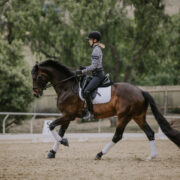Horsepower Like No Other: The American Thoroughbred

Nic Roldan may be the ultimate equestrian human athlete, but in polo, he’s nothing without the supreme athleticism of the horse underneath him.
His mount of choice for the top polo tournaments in the world? The American Thoroughbred.
“I truly believe that the good American Thoroughbreds are some of the best athletes in the world,” he said. Ten of the 14 horses he currently has in work are Thoroughbreds, and he sources many of those “polo ponies” off the track.
“It’s a very powerful horse, but they are very delicate at the same time. You have to be patient with them,” says Nic, 35, who is trains and lives in Wellington, Fla. “They are fast, they have big hearts, a lot of power and agility, a lot of handle, and can stop and turn super quickly.”
All of that is exactly what a top-level polo player needs in a horse, he says.
While some of Nic’s fellow riders have previously ridden Argentinian Thoroughbreds, many are beginning to look for American bloodlines to incorporate into their breeding programs, he says. Some Thoroughbreds are purpose-bred for polo, but others are found on the racetrack before they begin their racing career.
“We’re picking smaller Thoroughbreds, and the ones we get off the racetrack are usually too small to race or to be competitive. They’re in the 15-15.3h size range,” explained Nic, who stands six-feet tall. “Polo ponies” – while they aren’t all technically ponies – are on the smaller side as the sport requires riders to reach toward the ground with a mallet. During matches, Nic can switch out horses to give the tired ones a break, and does it literally by jumping from one saddle into another.
What Makes The Thoroughbred So Versatile?
Nic is passionate about promoting the American Thoroughbred as an elite athlete beyond the racetrack, and has worked on campaigns with the Thoroughbred Aftercare Alliance to promote the breed to riders of all disciplines.
“It’s great to have athletes like Nic talk about the use of the Thoroughbred at a high level of competition because I think a lot of people think the breed after racing is good for a weekend warrior type athlete,” said Stacie Clark, operations consultant of the Thoroughbred Aftercare Alliance based in Lexington, Ky.
It’s no secret that the vast majority of American Thoroughbreds are produced for and competed by the Thoroughbred racing industry. But these days, thanks in part to efforts to organizations like TTC, Retired Racehorse Project, CANTER, and other networks aimed at finding second careers for Thoroughbreds after racing, more Thoroughbreds are competing in other disciplines – not just polo.
“People come back to the Thoroughbred because they want that quick turn of foot and that forwardness.”
At the 2017 Rolex Kentucky CCI4*, there were nine full-blooded American Thoroughbreds on the entry list, with many, many more entries containing Thoroughbred bloodlines. These days, many event horses are at least partially Thoroughbred, because of the galloping stamina and forward-thinking attitude that the breed is known for. While warmbloods still dominate the hunter/jumper and dressage rings, it seems that the tide is changing, and riders and breeders alike are returning to the options of bloodlines available in the American Thoroughbred breed to refine their sport horses, says Stacie.
“Thoroughbreds were a very popular sport horse breed before the 80s. Rodney Jenkins, Michael Matz, they always rode Thoroughbreds in big competitions, and then the trend became, ‘Let’s find horses that are a bigger, quieter, and that we can point at jumps with someone,’ and it worked better with the warmblood,” she explained.

As the number of amateurs in the sport grew, the number of warmbloods did, too, and the Thoroughbred “fell out of favor”.
“The warmblood became the easier car to manipulate. But people come back to the Thoroughbred because they want that quick turn of foot and that forwardness – Thoroughbreds are very forward, and they’re not going to say ‘no’,” Stacie said. “So I don’t think Thoroughbreds became second hand, I think they just fell out of fashion. And now I’m noticing a trend where people want to reconsider the sincerity of the Thoroughbred mind that says, ‘What do you want to do, and how do you want to get there?’”
How To Train The Ultimate Polo Pony
For Nic to turn the young ones into polo superstars, he typically likes to buy them and bring them into his program at age four or five. Then he puts about a year or two of training into them, and they begin competing around six or seven.
“The horses don’t start playing super competitively until they are at least seven,” he said. “Back in the day they’d start them (in polo matches) at four or five but then by the time they were eight or so, they were done. I think people have realized that if you wait a little bit longer, their longevity is much better. I have horses that are 15-18 years old that are still playing.”
Speaking of longevity, fitness and time off are another huge part of Nic’s horse care program. Polo is physically demanding and high-impact for both horse and rider, so giving the horses’ bodies plenty of time to rest and recover during the year is crucial, Nic says.
“The horses get about three or four months off a year, sometimes even more. The really good ones will play four months a year then they’ll be off for four to five months, and then they’ll be brought back in to start getting legged up.”
He is able to give them a lengthy vacation by rotating the groups of horses he has in work. This also decreases the rate of injury and increases the longevity of Nic’s herd. The horses’ fitness and nutrition regime, much like Nic’s, is carefully planned.
“It’s all about building that fitness layer by layer, that’s one of the most technical parts.”
“We have special fitness programs and feeding programs, because the horses are elite athletes just like us. Once we get them out of the field, they just walk for about an hour in the morning and hour in the afternoon for two weeks. Then you start trotting them in sets of four or five horses and you walk for an hour, then trot ten minutes.” Then, Nic says, they add five minutes of trotting each week or so, until they are trotting for nearly half an hour. That’s just the base fitness plan before they go back into training.
“It’s like a human who has been a couch potato going to train for a marathon. You’re not going to go run 13 miles the first day. You have to build up to it. It’s all about building that fitness layer by layer, that’s one of the most technical parts (of the program),” he described.
The long and slow legging up process is “a pain” he says, “but well worth it”. It’s clear that Nic has an enormous amount of respect for his equine teammates and is committed to advancing the visibility of the American Thoroughbred – not as a second-hand horse off the track, but as a primary, go-to breed for elite athleticism.
“The American Thoroughbreds are definitely the ultimate athlete. They give their all 100 percent of the time. They love their jobs and are passionate about it just like the riders are,” he said. “In polo, we get a lot of horses off the track and they do amazing things for us, so we need to continue to promote these horses.”


